Per voi una miniguida dedicata a cosa vedere in un giorno a Bevagna, ma anche cosa fare e cosa mangiare in una delle cittadine medievali umbre più caratteristiche, a partire dalle antiche mura che la cingono.
Consigliamo infatti di partire da un giro tutto attorno all’imponente cinta muraria, ancora oggi presente quasi per l’intero perimetro. Entrate poi in città attraverso una delle porte medievali di accesso, ancora ottimamente conservate.
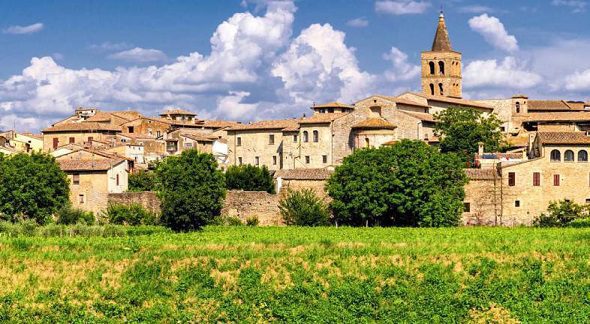
Scoprire Bevagna
Cominciamo il nostro tour alla scoperta di questo gioiellino umbro dal punto più alto della città, nelle vicinanze di piazza Garibaldi, da cui si scorgono la chiesa e il convento di San Francesco edificati alla fine del XIII sec. La facciata si presenta con un elegante portale e all’interno percorrendo la sola navata, si ammirano i dipinti di Dono Doni e Ascensidonio Spacca e i resti di affreschi del XVI sec. Alla sinistra dell’altare, protetta da una grata, è esposta la pietra dove, secondo la tradizione, poggiò i piedi San Francesco durante la “predica agli uccelli” in località Pian D’Arca.
Nelle vicinanze troviamo anche una cappella dedicata alla Madonna di Loreto attribuita a Galeazzo Alessi, che presenta un Tabernacolo del XV sec. ed una cupola decorata con pregevoli terrecotte invetriate, attribuite a Santi Buglioni.
Scendiamo poi in Piazza Silvestri, centro nevralgico della cittadina, con la sua forma irregolare e molto caratteristica. Qui si trovano il Palazzo dei Consoli e 3 chiese: la chiesa di San Michele, la chiesa di S. Domenico e la chiesa di San Silvestro Giacomo.
Il Palazzo dei Consoli pare sia stato costruito da Maestro Prode nel 1270; presenta sulla facciata bifore gotiche e una bellissima scalinata che porta ad un’ampia loggia coperta da volte a crociera. Dal 1886 al suo interno ospita il Teatro Torti, un gioiellino che può accogliere solo 140 posti, interamente decorato dalle sapienti mani di Domenico Bruschi e Mariano Piervittori.
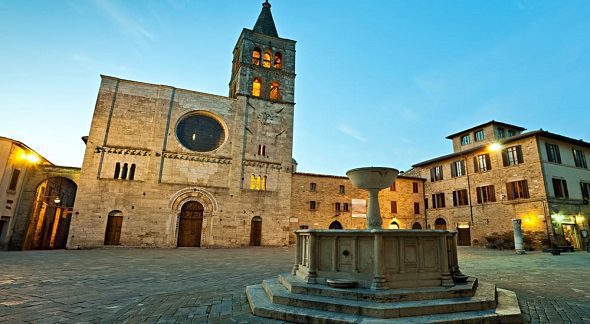
La chiesa di San Michele, che fu costruita nel XIII sec.per opera del Maestro Binello e di Rodolfo, presenta un’architetura a tre navate, e nell’interno si trovano le seguenti opere: un Crocifisso ligneo del XV sec.; sculture della Madonna, la Maddalena, e S. Giovanni attribuite al Providoni; una statua d’argento di San Vincenzo di Peter Ramoser realizzata tra il 1785 ed il 1795; un’effìge processionale del 1638 dedicata a S. Vincenzo.
La chiesa di S. Domenico e Giacomo del 1291, stata costruita su un preesistente oratorio donato al Beato Giacomo Bianconi dal Comune.La facciata presenta un portale con sopra una lunetta affrescata. Nell’interno (organizzato con una navata), sono presenti nella controfacciata e nell’abside vari affreschi del ‘300; dipinti del XVI e XVII sec. del bevenate Ascensidonio Spacca (detto il Fantina); sculture lignee del ‘200; altari settecenteschi.In un’urna, riposano le spoglie del Beato Giacomo. Il chiostro della chiesa custodisce degli affreschi di Giovan Battista Pacetti che raccontano scene della vita del Beato Giacomo.
La chiesa di San Silvestro, anch’essa con facciata romanica, ci accoglie con un elegante portale sulla cui sommità poggia una trifora e due bifore. Come riportano le cronache e una lapide posta entrando all’interno della chiesa sulla destra, la chiesa di san Silvestro fu costruita su progetto di Maestro Binello nel 1195 e fu poi restaurata nel 1954. All’interno possiamo notare la presenza di tre navate. Qui sono presenti affreschi di scuola Umbra.
Cosa vedere a Bevagna dopo le bellezze di Piazza Silvestri? Percorrete via Santa Margherita per giungere dinnanzi alla chiesa e Monastero di Santa Margherita, ristrutturata nel XVII sec. Qui potrete ammirare un affresco del 1592 di Ascensidonio Spacca e due Pale di Andrea Camassei sistemate sulla emozionante Scala Santa (così chiamata, perché percorrendola, si ottenevano le stesse indulgenze dell’omonima Scala Santa di Roma) realizzata dal Providoni.
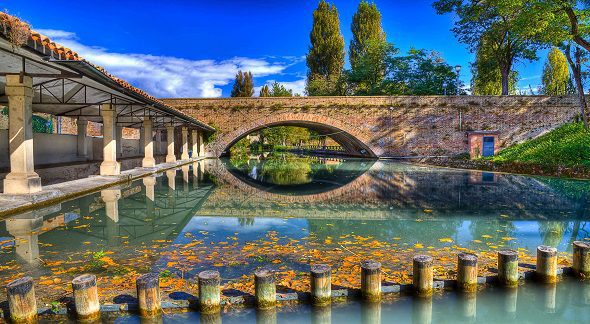
>> Ci sono offerte in scadenza! Consultare ora e trova quella giusta per te nella zona di Bevagna
Cosa fare a Bevagna
E’ molto interessante scoprire all’interno di Bevagna alcuni importanti resti risalenti all’epoca romanica: un Tempio del Il sec. d.C., una costruzione termale (del Il sec.d.C.) che preserva al suo interno uno stupendo mosaico; infine i resti del Teatro Romano. Le sale che ospitano i resti delle terme romane (II sec. d.C.) presentano mosaici a grosse tessere bianche e nere che raffigurano tipici soggetti che attingono al repertorio mitologico ed ornamentale di tipo marino: tritone ed ippocampo, polipi, delfini, aragoste. Il teatro romano è oggi adibito a laboratorio per la lavorazione delle ceramiche.
Cosa fare a Bevagna a Giugno? Se avete la fortuna di capitare a Bevagna nell’ultima decade di giugno vi imbatterete in una delle più belle manifestazioni storiche di tutta l’Umbria: il Mercato delle Gaite. In questa occasione, personaggi in costume ripropongono antichi mestieri lungo vicoli e ambienti caratteristici, con degustazione di antichi sapori medievali e presentazione delle produzioni artigianali tipiche. Qui un approfondimento sull’ultima edizione delle Gaite.
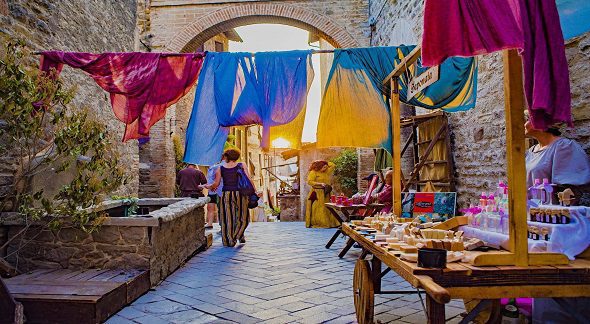
Cosa mangiare a Bevagna
Come tutti i borghi dell’Umbria anche Bevagna può vantare una ricca tradizione culinaria, tanto da aver pubblicato dei libri di ricette. Raccogliamo per voi qualche tipicità del territorio per farvi scegliere tra i tanti piatti cosa mangiare a Bevagna.
Una specialità della zona sono le lumache, anche dette chiocciole: si distinguono in lumachelle (piccole, bianche e rigate) e in lumacci (più grosse e di colore scuro) e vengono cucinate in umido.
Siamo sulla Strada del Sagrantino, non perdetevi gli gnocchi al Sagrantino e gli gnocchi ripieni di carne, una ricetta che proviene direttamente dalla cucina del Monastero delle Suore Benedettine di Santa Maria al Monte.
Tra gli antipasti, i crostini con fegatini e milza sono tra i più saporiti e se non sapete cosa mangiare a Bevagna come dolce ricordate che i tozzetti col vinsanto qui sono una vera e propria istituzione!
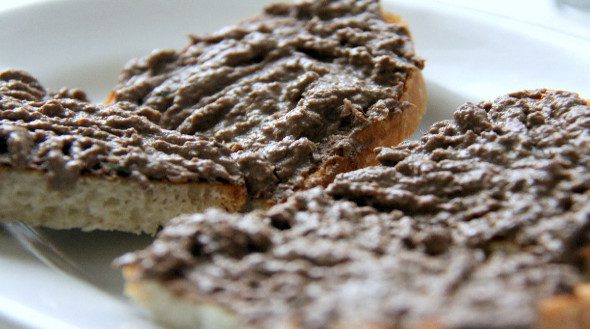
>> Consulta i ristoranti migliori nella zona di Bevagna!
Would you like to discover what are the best things to do in Bevagna? Here is a mini guide to find out what to see, things to do and foods to eat in Bevagna , precious medieval town surrounded by big, ancient walls.
>> Do you want to visit Bevagna? Check it out now of the best hotels in Bevagna, Italy
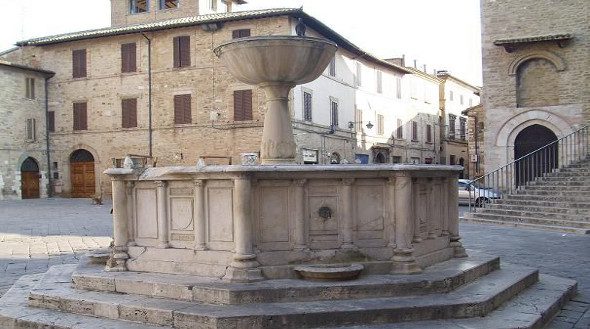
Let’s start our tour to discover this Umbria’s treasure from the highest point of the city, close to Piazza Garibaldi, where you can see the church and convent of San Francesco built in the late thirteenth century. The facade has an elegant portal and inside along the nave, you can admire the paintings by Dono Doni and Ascensidonio Spacca and the remains of frescoes of the sixteenth century. Near the altar, protected by a grate, is exposed the stone where, according to tradition, St. Francis put his feet during the ” preaching to the birds ” in Pian D’Arca. There are also a chapel attributed to Galeazzo Alessi , which has a Tabernacle of the fifteenth century and a dome decorated with fine glazed earthenware , attributed to Santi Buglioni .
>> Do you want to visit Bevagna and discover its treasures? Check it out now the best Farm-Houses in Bevagna
Let’s visit Piazza Silvestri, the center of the town, very characteristic with its irregular shape. Here you will find Palazzo dei Consoli and 3 churches : the church of San Michele, the church of S. Domenico and the church of San Silvestro Giacomo. Palazzo dei Consoli which seems to have been built by Maestro Prode in 1270, has in its facade Gothic windows and a beautiful staircase leading to a large covered loggia with cross vaults . Since 1886 it also hosts the Teatro Torti that can accommodate only 140 seats, fully decorated by the skilled hands of Domenico Bruschi and Mariano Piervittori . The church of St. Michael, which was built in the thirteenth century has three naves, and inside you will find many artists’ works. The church of S. Domenico was built in 1291 on an oratory. La facade has a portal with over a frescoed lunette. Inside there are various frescoes and paintings of the sixteenth and seventeenth century. The church of San Silvestro Giacomo, also with a Romanesque facade , was built and designed by Maestro Binello in 1195 and was later restored in 1954. Inside we can note the presence of three naves. Here are frescoes of the Umbrian school.
After admiring the beauties of Piazza Silvestri what are the things to do in Bevagna? Walk along Via Santa Margherita to see the church and Monastery of Santa Margherita, renovated in the seventeenth century. Here you can admire a fresco of 1592 and two of Ascensidonio Spacca and two works of Andrea Camassei arranged on Scala Santa (so named because covering it , were obtained by the same indulgences homonymous Scala Santa in Rome) made by Providoni.
Things to do in Bevagna
Among our suggestions on things to do in Bevagna we can not miss a ride around the city walls, still standing in almost their entire perimeter .
There are offers for vacation rentals and hotels in the areas of Bevagna! Click and Consult them immediately.
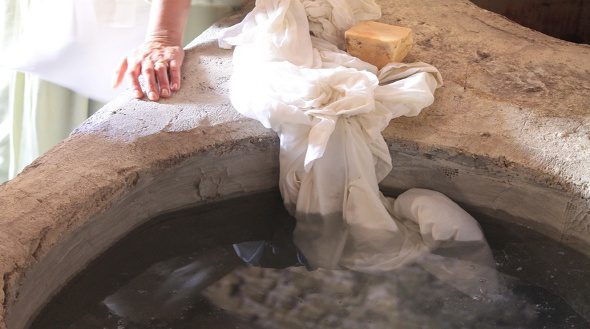
It ‘s very interesting to find out in Bevagna some important remains dating back to the Romanesque period: a Temple, a thermal construction which preserves inside a beautiful mosaic and the remains of the Roman Theatre.. Mosaics are black and white and represents typical mythological subjects that draw on repertoire and ornamental marine type : triton and hippocampus , octopus, dolphins , lobsters. The Roman theater is now used as a laboratory for processing of ceramics.
What are th best things to do in Bevagna in June? If you are so lucky to visit Bevagna in the last ten days of June you’ll come across one of the most beautiful historical events of Umbria: the Mercato delle Gaite. In this occasion, costumed characters revive ancient crafts along narrow streets and typical environments, with tasting of traditional medieval flavors and presentation of typical craft products.
Bevagna’s food, Umbrian cuisine, Italian food
Like all Umbria towns in Bevagna you will see a very rich culinary tradition. We collect for you some typical foods of the territory to let you choose between the many dishes what to eat in Bevagna .
See the best restaurants in the area of Bevagna! >> Click here and book.

A specialty of the area are the snails also known as chiocciole cooked stew. Bevagna stands on the Strada del Sagrantino; do not miss gnocchi with sagrantino and meat-filled gnocchi, a recipe that comes from the kitchen of the Monastery of the Benedictine Sisters of Santa Maria al Monte.
Among the appetizers , crostini with chicken liver and spleen are among the most flavorful and if you do not know what to eat in Bevagna remember that Tozzetti con Vin Santo here are an institution!
If you’ve decided to visit Bevagna and taste the delicious Umbrian cuisine you should contact now Farm-Houses near Bevagna >> click this link.
Would you like to discover what are the best things to do in Bevagna? Here is a mini guide to find out what to see, things to do and foods to eat in Bevagna , precious medieval town surrounded by big, ancient walls.
>> Do you want to visit Bevagna? Check it out now of the best hotels in Bevagna, Italy

Let’s start our tour to discover this Umbria’s treasure from the highest point of the city, close to Piazza Garibaldi, where you can see the church and convent of San Francesco built in the late thirteenth century. The facade has an elegant portal and inside along the nave, you can admire the paintings by Dono Doni and Ascensidonio Spacca and the remains of frescoes of the sixteenth century. Near the altar, protected by a grate, is exposed the stone where, according to tradition, St. Francis put his feet during the ” preaching to the birds ” in Pian D’Arca. There are also a chapel attributed to Galeazzo Alessi , which has a Tabernacle of the fifteenth century and a dome decorated with fine glazed earthenware , attributed to Santi Buglioni .
>> Do you want to visit Bevagna and discover its treasures? Check it out now the best Farm-Houses in Bevagna
Let’s visit Piazza Silvestri, the center of the town, very characteristic with its irregular shape. Here you will find Palazzo dei Consoli and 3 churches : the church of San Michele, the church of S. Domenico and the church of San Silvestro Giacomo. Palazzo dei Consoli which seems to have been built by Maestro Prode in 1270, has in its facade Gothic windows and a beautiful staircase leading to a large covered loggia with cross vaults . Since 1886 it also hosts the Teatro Torti that can accommodate only 140 seats, fully decorated by the skilled hands of Domenico Bruschi and Mariano Piervittori . The church of St. Michael, which was built in the thirteenth century has three naves, and inside you will find many artists’ works. The church of S. Domenico was built in 1291 on an oratory. La facade has a portal with over a frescoed lunette. Inside there are various frescoes and paintings of the sixteenth and seventeenth century. The church of San Silvestro Giacomo, also with a Romanesque facade , was built and designed by Maestro Binello in 1195 and was later restored in 1954. Inside we can note the presence of three naves. Here are frescoes of the Umbrian school.
After admiring the beauties of Piazza Silvestri what are the things to do in Bevagna? Walk along Via Santa Margherita to see the church and Monastery of Santa Margherita, renovated in the seventeenth century. Here you can admire a fresco of 1592 and two of Ascensidonio Spacca and two works of Andrea Camassei arranged on Scala Santa (so named because covering it , were obtained by the same indulgences homonymous Scala Santa in Rome) made by Providoni.
Things to do in Bevagna
Among our suggestions on things to do in Bevagna we can not miss a ride around the city walls, still standing in almost their entire perimeter .
There are offers for vacation rentals and hotels in the areas of Bevagna! Click and Consult them immediately.

It ‘s very interesting to find out in Bevagna some important remains dating back to the Romanesque period: a Temple, a thermal construction which preserves inside a beautiful mosaic and the remains of the Roman Theatre.. Mosaics are black and white and represents typical mythological subjects that draw on repertoire and ornamental marine type : triton and hippocampus , octopus, dolphins , lobsters. The Roman theater is now used as a laboratory for processing of ceramics.
What are th best things to do in Bevagna in June? If you are so lucky to visit Bevagna in the last ten days of June you’ll come across one of the most beautiful historical events of Umbria: the Mercato delle Gaite. In this occasion, costumed characters revive ancient crafts along narrow streets and typical environments, with tasting of traditional medieval flavors and presentation of typical craft products.
Bevagna’s food, Umbrian cuisine, Italian food
Like all Umbria towns in Bevagna you will see a very rich culinary tradition. We collect for you some typical foods of the territory to let you choose between the many dishes what to eat in Bevagna .
See the best restaurants in the area of Bevagna! >> Click here and book.

A specialty of the area are the snails also known as chiocciole cooked stew. Bevagna stands on the Strada del Sagrantino; do not miss gnocchi with sagrantino and meat-filled gnocchi, a recipe that comes from the kitchen of the Monastery of the Benedictine Sisters of Santa Maria al Monte.
Among the appetizers , crostini with chicken liver and spleen are among the most flavorful and if you do not know what to eat in Bevagna remember that Tozzetti con Vin Santo here are an institution!
If you’ve decided to visit Bevagna and taste the delicious Umbrian cuisine you should contact now Farm-Houses near Bevagna >> click this link.
Would you like to discover what are the best things to do in Bevagna? Here is a mini guide to find out what to see, things to do and foods to eat in Bevagna , precious medieval town surrounded by big, ancient walls.
>> Do you want to visit Bevagna? Check it out now of the best hotels in Bevagna, Italy

Let’s start our tour to discover this Umbria’s treasure from the highest point of the city, close to Piazza Garibaldi, where you can see the church and convent of San Francesco built in the late thirteenth century. The facade has an elegant portal and inside along the nave, you can admire the paintings by Dono Doni and Ascensidonio Spacca and the remains of frescoes of the sixteenth century. Near the altar, protected by a grate, is exposed the stone where, according to tradition, St. Francis put his feet during the ” preaching to the birds ” in Pian D’Arca. There are also a chapel attributed to Galeazzo Alessi , which has a Tabernacle of the fifteenth century and a dome decorated with fine glazed earthenware , attributed to Santi Buglioni .
>> Do you want to visit Bevagna and discover its treasures? Check it out now the best Farm-Houses in Bevagna
Let’s visit Piazza Silvestri, the center of the town, very characteristic with its irregular shape. Here you will find Palazzo dei Consoli and 3 churches : the church of San Michele, the church of S. Domenico and the church of San Silvestro Giacomo. Palazzo dei Consoli which seems to have been built by Maestro Prode in 1270, has in its facade Gothic windows and a beautiful staircase leading to a large covered loggia with cross vaults . Since 1886 it also hosts the Teatro Torti that can accommodate only 140 seats, fully decorated by the skilled hands of Domenico Bruschi and Mariano Piervittori . The church of St. Michael, which was built in the thirteenth century has three naves, and inside you will find many artists’ works. The church of S. Domenico was built in 1291 on an oratory. La facade has a portal with over a frescoed lunette. Inside there are various frescoes and paintings of the sixteenth and seventeenth century. The church of San Silvestro Giacomo, also with a Romanesque facade , was built and designed by Maestro Binello in 1195 and was later restored in 1954. Inside we can note the presence of three naves. Here are frescoes of the Umbrian school.
After admiring the beauties of Piazza Silvestri what are the things to do in Bevagna? Walk along Via Santa Margherita to see the church and Monastery of Santa Margherita, renovated in the seventeenth century. Here you can admire a fresco of 1592 and two of Ascensidonio Spacca and two works of Andrea Camassei arranged on Scala Santa (so named because covering it , were obtained by the same indulgences homonymous Scala Santa in Rome) made by Providoni.
Things to do in Bevagna
Among our suggestions on things to do in Bevagna we can not miss a ride around the city walls, still standing in almost their entire perimeter .
There are offers for vacation rentals and hotels in the areas of Bevagna! Click and Consult them immediately.

It ‘s very interesting to find out in Bevagna some important remains dating back to the Romanesque period: a Temple, a thermal construction which preserves inside a beautiful mosaic and the remains of the Roman Theatre.. Mosaics are black and white and represents typical mythological subjects that draw on repertoire and ornamental marine type : triton and hippocampus , octopus, dolphins , lobsters. The Roman theater is now used as a laboratory for processing of ceramics.
What are th best things to do in Bevagna in June? If you are so lucky to visit Bevagna in the last ten days of June you’ll come across one of the most beautiful historical events of Umbria: the Mercato delle Gaite. In this occasion, costumed characters revive ancient crafts along narrow streets and typical environments, with tasting of traditional medieval flavors and presentation of typical craft products.
Bevagna’s food, Umbrian cuisine, Italian food
Like all Umbria towns in Bevagna you will see a very rich culinary tradition. We collect for you some typical foods of the territory to let you choose between the many dishes what to eat in Bevagna .
See the best restaurants in the area of Bevagna! >> Click here and book.

A specialty of the area are the snails also known as chiocciole cooked stew. Bevagna stands on the Strada del Sagrantino; do not miss gnocchi with sagrantino and meat-filled gnocchi, a recipe that comes from the kitchen of the Monastery of the Benedictine Sisters of Santa Maria al Monte.
Among the appetizers , crostini with chicken liver and spleen are among the most flavorful and if you do not know what to eat in Bevagna remember that Tozzetti con Vin Santo here are an institution!
If you’ve decided to visit Bevagna and taste the delicious Umbrian cuisine you should contact now Farm-Houses near Bevagna >> click this link.
Would you like to discover what are the best things to do in Bevagna? Here is a mini guide to find out what to see, things to do and foods to eat in Bevagna , precious medieval town surrounded by big, ancient walls.
>> Do you want to visit Bevagna? Check it out now of the best hotels in Bevagna, Italy

Let’s start our tour to discover this Umbria’s treasure from the highest point of the city, close to Piazza Garibaldi, where you can see the church and convent of San Francesco built in the late thirteenth century. The facade has an elegant portal and inside along the nave, you can admire the paintings by Dono Doni and Ascensidonio Spacca and the remains of frescoes of the sixteenth century. Near the altar, protected by a grate, is exposed the stone where, according to tradition, St. Francis put his feet during the ” preaching to the birds ” in Pian D’Arca. There are also a chapel attributed to Galeazzo Alessi , which has a Tabernacle of the fifteenth century and a dome decorated with fine glazed earthenware , attributed to Santi Buglioni .
>> Do you want to visit Bevagna and discover its treasures? Check it out now the best Farm-Houses in Bevagna
Let’s visit Piazza Silvestri, the center of the town, very characteristic with its irregular shape. Here you will find Palazzo dei Consoli and 3 churches : the church of San Michele, the church of S. Domenico and the church of San Silvestro Giacomo. Palazzo dei Consoli which seems to have been built by Maestro Prode in 1270, has in its facade Gothic windows and a beautiful staircase leading to a large covered loggia with cross vaults . Since 1886 it also hosts the Teatro Torti that can accommodate only 140 seats, fully decorated by the skilled hands of Domenico Bruschi and Mariano Piervittori . The church of St. Michael, which was built in the thirteenth century has three naves, and inside you will find many artists’ works. The church of S. Domenico was built in 1291 on an oratory. La facade has a portal with over a frescoed lunette. Inside there are various frescoes and paintings of the sixteenth and seventeenth century. The church of San Silvestro Giacomo, also with a Romanesque facade , was built and designed by Maestro Binello in 1195 and was later restored in 1954. Inside we can note the presence of three naves. Here are frescoes of the Umbrian school.
After admiring the beauties of Piazza Silvestri what are the things to do in Bevagna? Walk along Via Santa Margherita to see the church and Monastery of Santa Margherita, renovated in the seventeenth century. Here you can admire a fresco of 1592 and two of Ascensidonio Spacca and two works of Andrea Camassei arranged on Scala Santa (so named because covering it , were obtained by the same indulgences homonymous Scala Santa in Rome) made by Providoni.
Things to do in Bevagna
Among our suggestions on things to do in Bevagna we can not miss a ride around the city walls, still standing in almost their entire perimeter .
There are offers for vacation rentals and hotels in the areas of Bevagna! Click and Consult them immediately.

It ‘s very interesting to find out in Bevagna some important remains dating back to the Romanesque period: a Temple, a thermal construction which preserves inside a beautiful mosaic and the remains of the Roman Theatre.. Mosaics are black and white and represents typical mythological subjects that draw on repertoire and ornamental marine type : triton and hippocampus , octopus, dolphins , lobsters. The Roman theater is now used as a laboratory for processing of ceramics.
What are th best things to do in Bevagna in June? If you are so lucky to visit Bevagna in the last ten days of June you’ll come across one of the most beautiful historical events of Umbria: the Mercato delle Gaite. In this occasion, costumed characters revive ancient crafts along narrow streets and typical environments, with tasting of traditional medieval flavors and presentation of typical craft products.
Bevagna’s food, Umbrian cuisine, Italian food
Like all Umbria towns in Bevagna you will see a very rich culinary tradition. We collect for you some typical foods of the territory to let you choose between the many dishes what to eat in Bevagna .
See the best restaurants in the area of Bevagna! >> Click here and book.

A specialty of the area are the snails also known as chiocciole cooked stew. Bevagna stands on the Strada del Sagrantino; do not miss gnocchi with sagrantino and meat-filled gnocchi, a recipe that comes from the kitchen of the Monastery of the Benedictine Sisters of Santa Maria al Monte.
Among the appetizers , crostini with chicken liver and spleen are among the most flavorful and if you do not know what to eat in Bevagna remember that Tozzetti con Vin Santo here are an institution!
If you’ve decided to visit Bevagna and taste the delicious Umbrian cuisine you should contact now Farm-Houses near Bevagna >> click this link.








Comment (0)